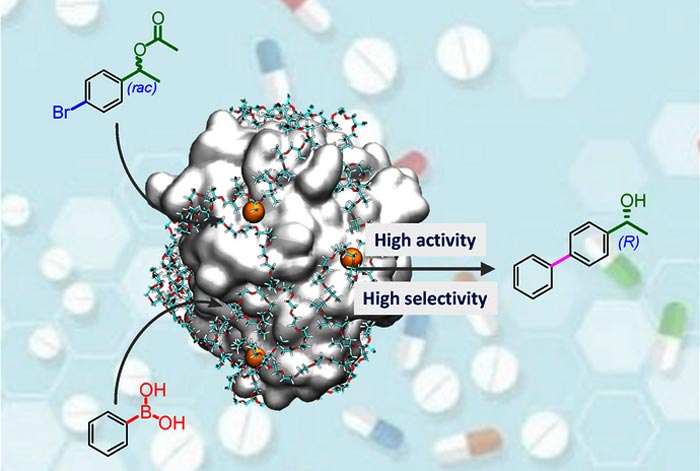Enzyme-metal-single-atom hybrid catalysts

An one-pot chemoenzymatic cascade reaction to synthesize chiral alcohol was realized by using the highly active and selective enzyme-metal-single-atom hybrid as the catalyst. The enzyme-metal-single-atom hybrid catalyst provides a promising strategy for effectively merging the enzymatic and single-atom catalysis.
Credit: Chinese Journal of Catalysis
… for efficient one-pot chemoenzymatic reactions.
The merging of different types of catalysis including enzymatic, homogeneous, and heterogeneous catalysis is fundamentally important for both understanding catalysis at the atom level and the design of novel hybrid catalysts. The latter points to a direction toward the ideal catalyst that can drive complex tandem reactions efficiently in one-pot manner, and simplify the whole chemical production and separation process. Artificial enzymes that merge enzymatic, homogeneous, and heterogeneous catalysis provide such a promising platform for developing novel hybrid catalysts that can operate to achieve the above goal efficiently under ambient conditions.
Directed evolution has been applied to tailor the active site of an enzyme with high efficiency, and artificial metalloenzymes have been generated by replacing the original metal atom at the active site by a new one. These methods are successful but usually only engineer the original active sites of enzymes, and this implies that the engineered enzyme may still be limited to catalyzing a single reaction. Inspired by the atomically dispersed metal catalysts that make a bridge between the homogeneous and heterogeneous catalysis, it is proposed that anchoring the metal single atoms to the nonactive sites of an enzyme can lead to an artificial enzyme with both its original active site and the new active sites of metal single atoms, merging the enzymatic and single-atom catalysis.
Recently, a research team led by Prof. Jun Ge from Tsinghua University reported the first enzyme-metal-single-atom hybrid catalyst that constructed by a photochemical approach. The Pd single atoms anchored lipase (Pd1/CALB-P) shows excellent activity and selectivity in the one-pot chemoenzymatic cascade reaction to asymmetric synthesize (R)-1-(4-biphenyl) ethanol. It can efficiently drive one-pot cascade reactions in aqueous solution at 30 oC to achieve facile synthesis of chiral biaryl alcohols, which are important pharmaceutical intermediates that traditionally require complex synthesis procedures. The rate of (R)-1-(4-biphenyl) ethanol formation catalyzed by Pd1/CALB-P is more than 30-fold higher than that of the combination of commercial palladium on carbon (Pd/C) and lipase-pluronic conjugate (CALB-P). The enzyme-metal-single-atom hybrid catalyst provides a promising strategy for effectively merging the enzymatic and single-atom catalysis. The results were published in Chinese Journal of Catalysis (https://doi.org/10.1016/S1872-2067(22)64179-2).
About the Journal
Chinese Journal of Catalysis is co-sponsored by Dalian Institute of Chemical Physics, Chinese Academy of Sciences and Chinese Chemical Society, and it is currently published by Elsevier group. This monthly journal publishes in English timely contributions of original and rigorously reviewed manuscripts covering all areas of catalysis. The journal publishes Reviews, Accounts, Communications, Articles, Highlights, Perspectives, and Viewpoints of highly scientific values that help understanding and defining of new concepts in both fundamental issues and practical applications of catalysis. Chinese Journal of Catalysis ranks among the top two journals in Applied Chemistry with a current SCI impact factor of 12.92. The Editors-in-Chief are Profs. Can Li and Tao Zhang.
At Elsevier http://www.journals.elsevier.com/chinese-journal-of-catalysis
Manuscript submission https://mc03.manuscriptcentral.com/cjcatal
Journal: Chinese Journal of Catalysis
Article Title: Enzyme-metal-single-atom hybrid catalysts for one-pot chemoenzymatic reactions
Article Publication Date: 2-Dec-2022
Media Contact
Fan He
Dalian Institute of Chemical Physics, Chinese Academy Sciences
hef197@dicp.ac.cn
Office: 86-411-843-79240
All latest news from the category: Life Sciences and Chemistry
Articles and reports from the Life Sciences and chemistry area deal with applied and basic research into modern biology, chemistry and human medicine.
Valuable information can be found on a range of life sciences fields including bacteriology, biochemistry, bionics, bioinformatics, biophysics, biotechnology, genetics, geobotany, human biology, marine biology, microbiology, molecular biology, cellular biology, zoology, bioinorganic chemistry, microchemistry and environmental chemistry.
Newest articles

A universal framework for spatial biology
SpatialData is a freely accessible tool to unify and integrate data from different omics technologies accounting for spatial information, which can provide holistic insights into health and disease. Biological processes…

How complex biological processes arise
A $20 million grant from the U.S. National Science Foundation (NSF) will support the establishment and operation of the National Synthesis Center for Emergence in the Molecular and Cellular Sciences (NCEMS) at…

Airborne single-photon lidar system achieves high-resolution 3D imaging
Compact, low-power system opens doors for photon-efficient drone and satellite-based environmental monitoring and mapping. Researchers have developed a compact and lightweight single-photon airborne lidar system that can acquire high-resolution 3D…





















